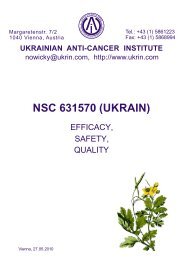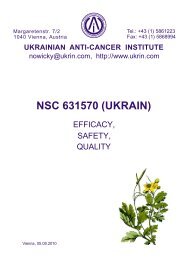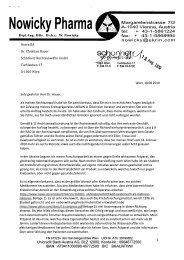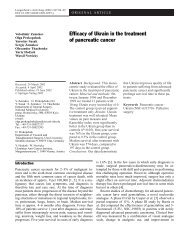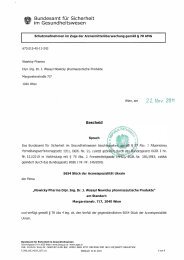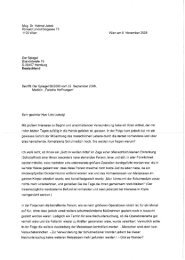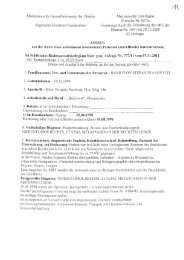Criminal Story of a Prevention - Ukrainian Anti Cancer Institute
Criminal Story of a Prevention - Ukrainian Anti Cancer Institute
Criminal Story of a Prevention - Ukrainian Anti Cancer Institute
Create successful ePaper yourself
Turn your PDF publications into a flip-book with our unique Google optimized e-Paper software.
particularly crucial is that Ukrain is the first and so far the only drug which attacks only<br />
cancer cells while leaving healthy cells undamaged, as demonstrated many times in vitro<br />
(including at the National <strong>Cancer</strong> <strong>Institute</strong>, Bethesda, USA).<br />
Numerous scientists are now investigating Ukrain. Pr<strong>of</strong>essor Liepins demonstrated<br />
Ukrain induced growth inhibition <strong>of</strong> one hundred percent on the same human tumour cell<br />
lines investigated at Bethesda and reported his findings at the 17 th International Chemotherapy<br />
Congress in Berlin in June 1991. This was confirmed by EORTC (European Organisation for<br />
Research and Treatment <strong>of</strong> <strong>Cancer</strong>) in Holland. The Mayo Clinic in the USA confirmed that<br />
Ukrain destroyed cancerous melanoma and breast cancer cells as well as other human cancer<br />
cells. Similar results were reported from Japan and at the University <strong>of</strong> Vermont the anticancer<br />
effect <strong>of</strong> Ukrain was even demonstrated on cells which had proved resistant to<br />
Cisplatin.<br />
It is all the more curious that the pharmacist, Reinhard Fischill from Vienna wrote a<br />
letter to the Austrian pharmacists’ journal (Österreichische Apotheker Zeitung, 20 May 1996)<br />
saying, ‘As a pharmacist it makes my hair stand on end,’ when he reads, ‘The alkaloid<br />
derivative from greater celandine attacks only tumour cells and leaves normal cells<br />
undamaged.’ In addition, he pokes fun at the experiments carried out by Dr. Thomas Tritton<br />
at the University <strong>of</strong> Vermont which had shown that Ukrain was also effective where Cisplatin<br />
had failed.<br />
Understandably, Nowicky was puzzled about the source from which Fischill drew his<br />
knowledge. All the documentation handed to the authorities for the registration process was<br />
confidential (as Dr. Jentzsch expressly assured me). The fact that Fischill worked closely with<br />
the Ministry <strong>of</strong> Health as a member <strong>of</strong> the Austrian Pharmacists’ Association and particularly<br />
that he is connected to the company Novipharm, which produces the mistletoe preparation<br />
Isorel, are far from being reasons to bring him to registration documentation, even those <strong>of</strong> a<br />
competitor. Isorel is used as an alternative cancer treatment; one that was quickly registered.<br />
In reaction to Fischill’s allegations in his letter, Jentzsch, who until now has blocked<br />
the registration <strong>of</strong> Ukrain, explained to me on 8 February 1994, ‘It is certainly no quack<br />
medicine. We are all interested, but if the requirements are not fulfilled, there will be no<br />
registration.’ Asked whether, in view <strong>of</strong> the studies available until then from all over the<br />
world, the researcher should not be given a grant for further research, Jentzsch replied, ‘The<br />
ministry (<strong>of</strong> health) has always demanded that with such important things there should be<br />
intensive…’ he interrupted and corrected himself, ‘intensive is maybe overstated…<br />
cooperation with the Ministry <strong>of</strong> Science.’<br />
At the Ministry <strong>of</strong> Science, however, there is another viewpoint. From 1984 the<br />
Research Department had, as the only government <strong>of</strong>fice, greatly promoted Nowicky’s work.<br />
In addition to the grants already mentioned, in 1992 and 1996 two special editions <strong>of</strong> the<br />
journal Drugs Under Research were sponsored in which the most important results <strong>of</strong><br />
Austrian and foreign researchers were collected. The first special edition <strong>of</strong> 109 pages was<br />
presented at a symposium organised by the Ministry <strong>of</strong> Science under the then minister, Dr.<br />
Erhard Busek on 25 May 1993. <strong>Cancer</strong> specialists and doctors were invited to hear talks<br />
delivered by scientists from Austria and abroad under the title ‘New Methods <strong>of</strong> <strong>Cancer</strong><br />
Treatment – the Example <strong>of</strong> Ukrain’. This was not some obscure pamphlet by dubious authors<br />
but serious scientific contributions from serious researchers.<br />
Years later, in the Oncological Department <strong>of</strong> Vienna General Hospital, I found out<br />
what clinical circles thought about an initiative like this. After Dr. S. had said in a radio<br />
discussion on 7 February 1997 that Ukrain was carcinogenic, I visited him a few weeks later<br />
at the hospital because I wanted to know what experimental results had led him to this<br />
statement which appears nowhere else in any literature on Ukrain.<br />
However, as soon as we began talking, he threatened me with legal action if I named<br />
him in any report <strong>of</strong> our conversation. This was already disappointing. There had been no<br />
31



